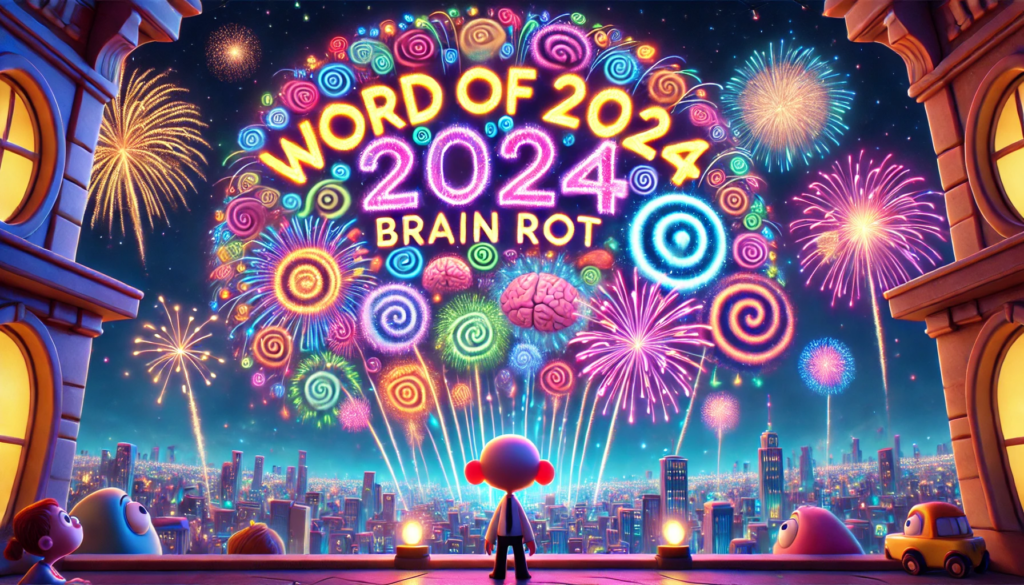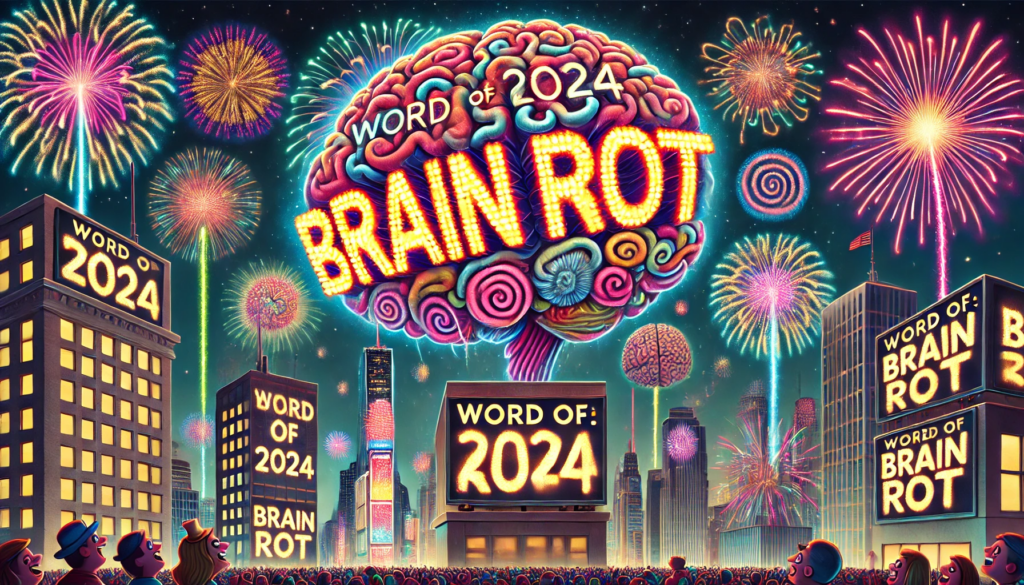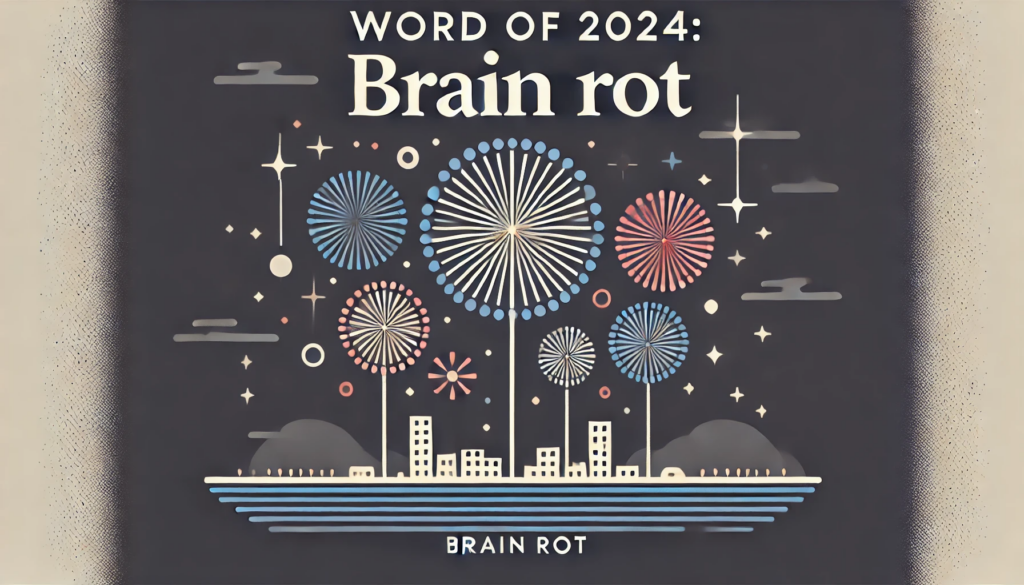
ChatGPT:
“Brain Rot” is an informal term used to describe a perceived decline in cognitive abilities or intellectual engagement. It suggests that the brain is deteriorating—or “rotting”—due to lack of stimulation or overexposure to mindless activities. This term is often employed humorously or critically to comment on habits that are considered mentally unchallenging.
Origin
The phrase combines the words “brain” and “rot” to create a vivid metaphor for mental decay. While there’s no precise origin date, the term emerged from colloquial language to express concerns about activities thought to dull the mind. It gained popularity alongside the rise of mass media and digital entertainment, where passive consumption became more common.
Meaning and Usage
• Excessive Screen Time: Spending prolonged periods watching television, scrolling through social media, or playing video games without intellectual engagement.
• Lack of Mental Stimulation: Engaging in repetitive or unchallenging tasks that don’t promote critical thinking or learning.
• Cultural Commentary: Used to critique societal trends that prioritize entertainment over education or meaningful interaction.
Example in a Sentence:
• “I’ve been binge-watching reality shows all weekend—I can feel the brain rot setting in.”
Cultural Context
• Self-Deprecation: People might jokingly use the term to acknowledge their own unproductive habits.
• Criticism: Educators or parents might use it to caution against activities that don’t contribute to personal growth.
• Internet Slang: In online communities, it can refer to getting overly absorbed in memes or content with little substantive value.
Conclusion
“Brain Rot” serves as a metaphorical warning against intellectual complacency. It underscores the importance of engaging in activities that challenge the mind, promote learning, and foster critical thinking to maintain cognitive health.

Here are five more examples of how the term “brain rot” is used:
1. “I need to start learning a new language; I can feel the brain rot from not challenging myself.”
2. “Spending hours on those clickbait articles is pure brain rot.”
3. “She worries that her kids will get brain rot from playing video games all day.”
4. “After marathoning that shallow sitcom, I feel like I need to detox from the brain rot.”
5. “He’s afraid of retirement leading to brain rot, so he’s picking up new hobbies to stay sharp.”
Fun and Practical Ways to Prevent “Brain Rot”
Keeping your mind active doesn’t have to feel like work. Here are some enjoyable and practical activities to help stimulate your brain and keep it sharp:
1. Play Puzzle and Strategy Games
• Board Games: Engage in games like chess, Scrabble, or Settlers of Catan that require strategic thinking.
• Mobile Apps: Try brain-training apps like Lumosity, Peak, or Elevate for daily mental exercises.
• Escape Rooms: Participate in physical or virtual escape rooms with friends to solve puzzles collaboratively.
2. Learn a New Language
• Language Apps: Use apps like Duolingo or Rosetta Stone to make learning interactive and fun.
• Language Exchange Meetups: Practice speaking with native speakers while making new friends.
• Cultural Immersion: Watch movies or listen to music in the language you’re learning.
3. Take Up a Creative Hobby
• Artistic Pursuits: Try painting, drawing, or digital art to stimulate the right side of your brain.
• Writing: Start a blog, write poetry, or try your hand at creative writing prompts.
• Music: Learn to play a musical instrument or compose your own songs.
4. Stay Physically Active with a Twist
• Dance Classes: Learn new dance styles like salsa, hip-hop, or ballroom dancing.
• Martial Arts: Practices like karate or tai chi combine physical activity with mental discipline.
• Yoga and Meditation: Enhance your mind-body connection and improve concentration.
5. Engage in Social Learning
• Book Clubs: Join a local or online book club to read and discuss new books regularly.
• Workshops and Seminars: Attend events on topics that interest you, from cooking to astronomy.
• Volunteer: Teach a skill you have to others or participate in community projects.
6. Explore Science and Technology
• DIY Projects: Build gadgets, robots, or simple electronics kits.
• Coding: Learn programming languages through platforms like Codecademy or freeCodeCamp.
• Astronomy: Get a telescope and start stargazing, or join a local astronomy club.
7. Travel and Explore
• Local Adventures: Visit museums, historical sites, or art galleries in your area.
• Nature Trips: Go hiking, camping, or bird-watching to learn about the environment.
• Cultural Experiences: Attend festivals, try new cuisines, or learn traditional crafts.
8. Participate in Mental Challenges
• Trivia Nights: Test your knowledge at local trivia events or online quizzes.
• Debate Clubs: Join groups that encourage discussions on various topics.
• Mathematical Puzzles: Challenge yourself with Sudoku, Kakuro, or logic puzzles.
9. Cultivate a Reading Habit
• Diverse Genres: Read fiction, non-fiction, biographies, and science fiction to expand your horizons.
• Audiobooks and Podcasts: Explore new ideas and stories during commutes or workouts.
• Set Reading Goals: Challenge yourself to read a certain number of books each month.
10. Gardening and Nature Projects
• Start a Garden: Learn about botany while growing your own plants or vegetables.
• Environmental Activities: Participate in clean-up drives or conservation efforts.
• Nature Photography: Capture the beauty of the outdoors while honing your photography skills.
Additional Tips:
• Mix It Up: Regularly switch between different activities to keep things interesting and challenge different parts of your brain.
• Stay Curious: Ask questions, seek new experiences, and don’t hesitate to dive into topics you’re unfamiliar with.
• Make It Social: Involve friends or family members to make activities more enjoyable and to gain new perspectives.
• Set Personal Goals: Whether it’s finishing a book, mastering a song on an instrument, or completing a DIY project, having goals can boost motivation.
By incorporating these fun and engaging activities into your routine, you’ll not only prevent “brain rot” but also enrich your life with new skills and experiences.
Origin of the “Oxford Word of the Year”
The “Oxford Word of the Year” is an annual tradition established by the Oxford University Press (OUP), specifically by the editors of the Oxford Languages team, who are responsible for compiling the Oxford English Dictionary (OED). The initiative began in 2004 as a way to highlight a word or expression that has attracted a great deal of interest during the year. The chosen word reflects the ethos, mood, or preoccupations of that particular year and is intended to have lasting potential as a term of cultural significance.
Purpose and Significance
• Language Reflection: The Word of the Year showcases how language evolves in response to current events, technological advancements, and cultural shifts.
• Cultural Snapshot: It provides a linguistic snapshot of the year, encapsulating prevalent themes or societal changes.
• Public Engagement: The selection process and announcement engage the public in discussions about language and its development.
Selection Process
1. Data Collection: Lexicographers analyze millions of words in the Oxford Corpus, a vast database of English language usage from various sources like books, newspapers, blogs, and social media.
2. Shortlisting: Words that have seen a significant increase in usage or have emerged as new terms are shortlisted.
3. Evaluation Criteria:
• Frequency of Use: How much the word’s usage has increased over the year.
• Cultural Relevance: Its connection to significant events or trends.
• Potential Longevity: Whether the word is likely to remain in use.
4. Final Selection: A panel of experts debates the shortlisted words and selects the one that best represents the year.
Notable Examples
• 2005: “Podcast” – Reflecting the rise of digital media and personal broadcasting.
• 2013: “Selfie” – Highlighting the influence of social media and self-portraiture.
• 2015: “Face with Tears of Joy” emoji (😂) – The first pictograph chosen, acknowledging the impact of emojis on communication.
• 2016: “Post-truth” – Denoting a political culture where appeals to emotion outweigh factual evidence.
• 2019: “Climate emergency” – Emphasizing the growing concern over climate change.
• 2021: “Vax” – Capturing the prominence of vaccination in global discourse due to the COVID-19 pandemic.
Global Variations
• Regional Words: Oxford also selects Words of the Year for different English-speaking regions, such as the United States and the United Kingdom, to reflect regional linguistic trends.
• Other Languages: The initiative extends to other languages, with Oxford’s language teams selecting Words of the Year in languages like Spanish, German, and Hindi.
Impact on Language and Culture
• Dictionary Inclusion: Words chosen often gain or solidify their place in the Oxford Dictionaries.
• Cultural Awareness: Highlights how language responds to societal changes, bringing attention to important issues.
• Educational Resource: Used by educators to discuss language evolution and current events with students.
Conclusion
The “Oxford Word of the Year” originated as a means to track and highlight the dynamic nature of the English language. Since its inception in 2004, it has become a culturally significant event that not only reflects the changing linguistic landscape but also offers insight into the societal trends and issues that define each year. The tradition underscores the importance of language as both a mirror and a driver of cultural evolution.
Here are more examples of the Oxford Word of the Year from various years, along with brief explanations:
1. 2004: “Chav”
• A British term referring to a young person characterized by brash and loutish behavior, often wearing designer clothing.
2. 2006: “Carbon Neutral”
• Describes a state where the net carbon emissions of an individual, organization, or activity are zero.
3. 2007: “Locavore”
• A person who endeavors to eat only locally produced food.
4. 2008: “Hypermiling”
• The practice of making adjustments to a vehicle or driving habits to maximize fuel efficiency.
5. 2009: “Unfriend”
• To remove someone from a list of friends or contacts on social media platforms.
6. 2010: “Refudiate”
• Coined by Sarah Palin, blending “refute” and “repudiate,” meaning to reject an idea or statement.
7. 2011 (UK): “Squeezed Middle”
• A term popularized by UK politician Ed Miliband to describe the social group facing financial pressures due to economic policies.
8. 2011 (US): “Squeezed Middle”
• The same term was recognized in the US, reflecting global economic concerns.
9. 2012 (UK): “Omnishambles”
• Describes a situation that has been comprehensively mismanaged.
10. 2012 (US): “GIF”
• An acronym for Graphics Interchange Format, highlighting the resurgence of animated GIFs in digital communication.
11. 2014: “Vape”
• To inhale and exhale vapor produced by an electronic cigarette or similar device.
12. 2015: “😂” (Face with Tears of Joy Emoji)
• The first pictograph chosen as Word of the Year, reflecting the rise of emojis in digital communication.
13. 2017: “Youthquake”
• Signifies significant cultural, political, or social change arising from the actions or influence of young people.
14. 2018: “Toxic”
• Chosen due to its prevalence in contexts like “toxic environment,” “toxic relationships,” and “toxic culture.”
15. 2019: “Climate Emergency”
• Highlights the urgent need for action to address climate change.
16. 2020: No Single Word Chosen
• Due to the unprecedented nature of the year, Oxford Languages highlighted several significant words:
• “Pandemic”
• “Lockdown”
• “Social Distancing”
• “Key Worker”
• “Remote Learning”
17. 2021: “Vax”
• Short for “vaccine” or “vaccination,” reflecting the global focus on COVID-19 vaccination efforts.
18. 2022: “Goblin Mode”
• A slang term describing a type of behavior which is unapologetically self-indulgent, lazy, or greedy, typically in a way that rejects social norms or expectations.
These words capture the essence of each year, reflecting societal trends, technological advancements, and global events. They illustrate how language evolves and responds to the world around us.

